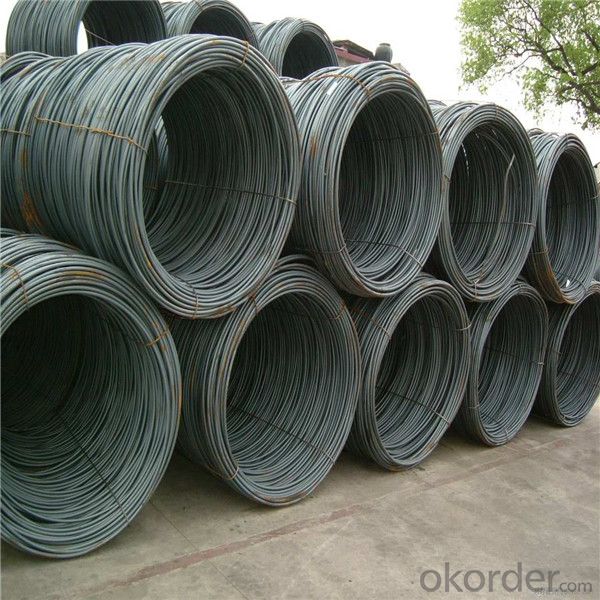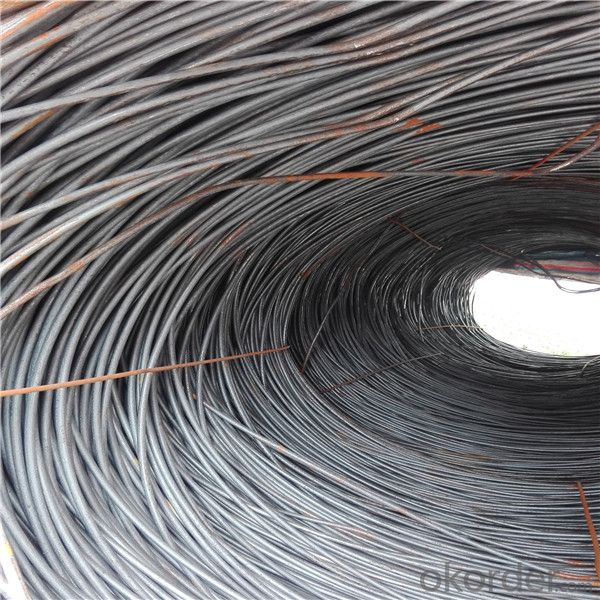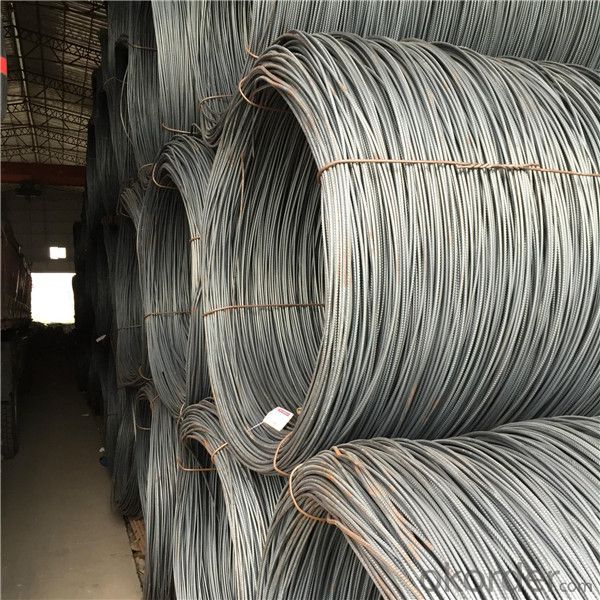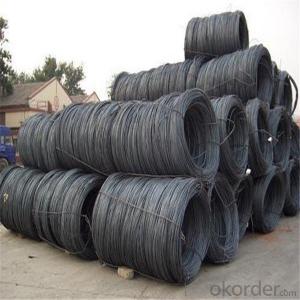Steel wire rod high carbon in different diamater
- Loading Port:
- Tianjin
- Payment Terms:
- TT OR LC
- Min Order Qty:
- 100 m.t.
- Supply Capability:
- 16532 m.t./month
OKorder Service Pledge
OKorder Financial Service
You Might Also Like
Item specifice
Drawing Grade wire rods are used by downstream industries for various applications such as making wires for
welded mesh, nails, hangers, screws, chain link & gabion fencing, wire nets, barbed wires and binding wires
Our Advantage: High quality steel products from 1 class mills in
Reasonable price
Professionalism of the products
On-time delivery
Complete documents and certificates
Sincere service to meet our clients' requirements
Product Description :
Standard | AISI, ASTM, BS, DIN, GB, JIS |
Material/steel grade | Q195-Q235,SAE1006B,SAE1006CR, SAE1008B, SAE1008CR, SAE1010B, SAE1018B, or according to customers requirements |
Wire Gauge | 5.5-12mm |
Coil weight | 1.8-2.1mts |
MOQ | 25MT |
Delivery Time | 15-30 days after receipt of L/C or deposit by T/T |
Packing | In coil and load in container, if large quantity, by bulk vessel; Can be packed as customers' special requirements |
Payment terms | 1).100% irrevocable L/C at sight. 2).30% T/T prepaid and the balance against the copy of B/L. 3).30% T/T prepaid and the balance against L/C |
Application | widely used in machinery parts, manufacturing industry, electronics industry, metal tools and others |



Application :
It generally used in braiding the hose for bathing product and machinery. With it
good flexibility, resistant to high temperature and resistant to corrosion, it
used widely in many industries.
Packing :
Hot-rolled wire rod is held in a unit with at least four steel straps in the
transverse direction and transported and stored without further packaging.
Before
the steel strapping is applied, the wire rod must be sufficiently compressed.
The strapping is fixed in the transverse direction with a single circumferential
strap so that the strapping does not slip and cause the coil to come apart.


Our service:
(1) We cooperate with famous factories with advanced equipment and well trained workers.
(2) We can provide factory price with trading company service.
(3) We continuously work on the improvement of our processes, guaranteeing
consistently high standards of quality to keep none compensation.
(4) We guarantee 24 hours response and 48 hours solution providing service.
(5) We accept small order quantity before formal cooperation.
(6) We deliver the agreed quality at the agreed time, reacting to changes in
customer wishes in a flexible way.
(7) Due to our volume and selling power, we have excellent freight rates with
shipping lines.
(8) We strive to always be fair and honest in our dealings with customers.
(9) We strive to work together with customers to achieve much more than we can
achieve alone.
(10) Through our passion and commitment we aim to be a market leader in all our
key markets. To maintain our position as market leader we must continue to add
value in all that we do.
FAQ:
1.Q: What's your MOQ(minimum order quantity)?
A: One full container, mixed acceptable .
2. Q: What's your packing methods?
A: Packed in bundle or bulk ..
3. Q: How can I buy CNBM products in my country?
A:Please send us an inquiry or email ,we will reply to you if there is distributor in your country
4. Q: Can we visit your factory?
A: Warmly welcome. Once we have your schedule, we will arrange the
professional sales team to follow up your case.
5. Q: How long does it take to get the product if i place an order?
A:With the process of your requirements,we will pack and deliver in 3
-7 days. If it is by sea shipment,it will take 15-45 days depending on different locations
- Q:How are steel wire rods used in the manufacturing of springs?
- Springs rely on steel wire rods as an essential part of their manufacturing process. These rods, typically crafted from high-quality steel, undergo a series of procedures such as hot rolling, cold drawing, and heat treatment to enhance their durability and strength. After the steel wire rods have been prepared, they are further processed to achieve the desired characteristics and shape for different types of springs. This can be accomplished by coiling, twisting, or bending the wire rods into specific forms. Due to their exceptional mechanical properties, like high tensile strength and flexibility, steel wire rods are the primary material for springs. These qualities are critical in resisting deformation and providing the necessary force when compressed or stretched. In addition, stringent quality control measures are implemented in the manufacturing of springs using steel wire rods. Tests evaluating the wire's mechanical properties, such as tensile strength, elasticity, and fatigue resistance, ensure consistency and reliability in performance. Overall, steel wire rods are crucial in the manufacturing of springs, providing the required strength and versatility for these essential components. Their ability to withstand various forces and maintain shape over time makes them a dependable choice for a wide range of applications in the automotive, aerospace, and industrial sectors.
- Q:What are the major players in the global steel wire rod market?
- ArcelorMittal, Nippon Steel Corporation, Tata Steel Ltd., POSCO, JFE Steel Corporation, Nucor Corporation, Steel Authority of India Limited (SAIL), EVRAZ plc, Gerdau S.A., and Sohar Steel LLC are among the key players in the global steel wire rod market. These companies are renowned manufacturers and suppliers of steel wire rod, which finds extensive application in industries like construction, automotive, and manufacturing. They possess a significant market share and maintain a strong presence in vital markets worldwide. To stay competitive, these industry leaders consistently invest in research and development to develop innovative products and enhance their production processes. They also prioritize strategic alliances, acquisitions, and expansion initiatives to broaden their market reach and fortify their position in the global steel wire rod market.
- Q:What are the main factors influencing the choice of steel wire rod dimensions?
- The main factors influencing the choice of steel wire rod dimensions are the intended application, the required mechanical properties, and the manufacturing process. Firstly, the intended application plays a crucial role in determining the dimensions of the steel wire rod. Different industries and products have specific requirements for the wire rod dimensions. For example, in the automotive industry, steel wire rods are used for making springs, cables, and reinforcements, and the dimensions need to be tailored to the specific components. Similarly, in the construction industry, steel wire rods are utilized for reinforcement in concrete structures, and the dimensions must be suitable for the desired strength and stability. Secondly, the required mechanical properties of the steel wire rod influence its dimensions. Factors such as tensile strength, yield strength, elongation, and ductility are considered when determining the dimensions. Higher strength requirements may necessitate a thicker wire rod, while greater ductility might require a thinner rod to allow for easier shaping or bending. Lastly, the manufacturing process also affects the choice of steel wire rod dimensions. The capabilities of the production line and the available equipment play a significant role. The dimensions should align with the capabilities of the manufacturing process to ensure efficient and cost-effective production. For instance, if a specific wire rod dimension is not compatible with the existing rolling mill equipment, it may require additional investments or modifications to accommodate the desired dimensions. In summary, the choice of steel wire rod dimensions is influenced by the intended application, the required mechanical properties, and the manufacturing process. Considering these factors ensures that the wire rod is suitable for its intended use, meets the necessary performance criteria, and can be efficiently produced.
- Q:How is steel wire rod used in the manufacturing of wire forms for conveyor systems?
- Wire forms for conveyor systems rely on steel wire rod as a vital ingredient in their production. This wire rod acts as the base material from which wire forms are fashioned. To enhance its strength, ductility, and flexibility, the wire rod undergoes a series of mechanical and thermal treatments, such as hot rolling, cold drawing, and annealing. Once the wire rod has been appropriately processed, it is shaped into various wire forms that are specifically tailored for conveyor systems. Examples of these wire forms include wire mesh belts, wire spirals, wire ropes, and wire hooks. Each wire form has a distinct purpose within the conveyor system, whether it be supporting the weight of the conveyed material, guiding the movement of the conveyor belt, or securing and fastening different components of the system. The selection of steel wire rod for manufacturing wire forms for conveyor systems is based on its high tensile strength, corrosion resistance, and durability. These qualities ensure that the wire forms can withstand the demanding operating conditions of conveyor systems, such as heavy loads, high speeds, and exposure to various environmental factors. In conclusion, steel wire rod plays a critical role in the manufacturing of wire forms for conveyor systems by providing the necessary raw material with the required mechanical properties. Its utilization guarantees the dependable and efficient operation of conveyor systems across diverse industries, including mining, manufacturing, transportation, and logistics.
- Q:What are the different types of steel wire rod coatings used for improved heat resistance?
- To enhance heat resistance, various coatings are commonly employed on steel wire rods. These coatings serve as protective barriers and bolster the wire rod's capacity to withstand elevated temperatures. Zinc is one of the most frequently utilized coatings for heat resistance. Zinc coatings, such as hot-dip galvanizing or zinc-aluminum alloy coatings, effectively shield the steel wire rod from heat and corrosion. By creating a sacrificial layer, the zinc coating prevents the underlying steel from encountering oxygen and moisture, thus minimizing the risk of oxidation and corrosion. Another coating employed to enhance heat resistance is aluminum. Through a process called aluminum thermal spraying, molten aluminum is sprayed onto the surface of the steel wire rod, forming a robust and heat-resistant barrier. This barrier helps maintain the wire rod's integrity when exposed to high temperatures. Apart from zinc and aluminum coatings, specialized coatings like ceramic coatings and high-temperature resistant polymer coatings are also utilized. Ceramic coatings, composed of inorganic materials, exhibit exceptional heat resistance, making them suitable for extreme temperature applications. Conversely, high-temperature resistant polymer coatings are organic coatings capable of withstanding high temperatures without degradation. In conclusion, the assortment of steel wire rod coatings employed for enhanced heat resistance varies in terms of protection and durability. The choice of coating depends on factors such as the specific application, operating temperature range, and desired level of heat resistance.
- Q:What are the common production processes for zinc-coated steel wire rod?
- The common production processes for zinc-coated steel wire rod include drawing, annealing, galvanizing, and cooling.
- Q:How is steel wire rod used in the production of wire ropes for mining applications?
- Steel wire rod is used as the primary raw material in the production of wire ropes for mining applications. It serves as the foundation for creating the wire strands that make up the rope. The wire rod is first cleaned and coated to enhance its durability and resistance to corrosion. It is then drawn through a series of dies to reduce its diameter and increase its strength. These drawn wires are then twisted or braided together to form the wire strands, which are further assembled into wire ropes used in mining operations. The high strength and resilience of steel wire rod make it a crucial component in ensuring the safety and reliability of wire ropes used in demanding mining conditions.
- Q:How is steel wire rod used in the manufacturing of wire baskets for industrial applications?
- Steel wire rod is a primary material used in the manufacturing of wire baskets for industrial applications. It serves as the base material that is shaped, bent, and welded to create the framework of the basket. The high tensile strength and durability of steel wire rod make it ideal for withstanding heavy loads and rough handling in industrial environments. Additionally, the steel wire rod can be coated or galvanized to enhance corrosion resistance, ensuring longevity and reliable performance of the wire baskets.
- Q:How is the steel wire rod market affected by changing customer preferences?
- Changing customer preferences have a significant impact on the steel wire rod market. The demand for specific types of steel wire rods can fluctuate as customer preferences evolve. One way in which changing customer preferences affect the market is through the demand for different grades of steel wire rods. For instance, if customers prefer higher strength and durability, there may be an increased demand for high-carbon steel wire rods. Conversely, if customers prioritize cost-effectiveness and flexibility, there may be a higher demand for low-carbon steel wire rods. Manufacturers need to adapt their processes to meet the requirements of the market, as these changing preferences influence the production and supply chain of steel wire rods. Furthermore, changing customer preferences also impact the use of steel wire rods in various industries. If there is a growing trend towards lightweight and eco-friendly products, industries like automotive and construction may shift towards using steel wire rods with specific characteristics that align with these preferences. This can lead to changes in the demand for different types of steel wire rods and affect the overall market dynamics. Moreover, customer preferences for sustainable and environmentally friendly materials can also influence the steel wire rod market. If customers prioritize materials with lower carbon emissions and higher recyclability, manufacturers may need to invest in new technologies or processes to produce steel wire rods that meet these preferences. This can result in changes in production methods, sourcing of raw materials, and overall market competitiveness. In conclusion, the steel wire rod market is highly sensitive to changing customer preferences. Manufacturers and suppliers must closely monitor and comprehend these preferences in order to effectively meet market demands and remain competitive. Adapting to evolving customer preferences is crucial for the growth and sustainability of the steel wire rod industry.
- Q:How is steel wire rod used in the manufacturing of wire forms for window blinds?
- Steel wire rod is a crucial component in the manufacturing of wire forms for window blinds. It serves as the primary material from which the wire forms are fabricated. Firstly, steel wire rod is selected for its high strength and durability, making it ideal for supporting the weight of blinds and withstanding daily use. It is essential that the wire forms are sturdy enough to hold the blinds in place and endure repeated opening and closing without losing their shape or functionality. The steel wire rod is typically processed through a series of manufacturing steps to transform it into the desired wire forms. These steps may include drawing, annealing, and coating processes. Drawing involves pulling the steel wire rod through a series of dies to reduce its diameter, resulting in a thinner and more flexible wire. Annealing is performed to relieve any internal stresses in the wire and enhance its ductility, making it easier to bend and shape. Finally, coating processes may be applied to provide additional protection against corrosion or to add aesthetic appeal. Once the steel wire rod has been processed, it is shaped into various forms for window blinds. These wire forms include tilt rod connectors, cord connectors, and control brackets. Tilt rod connectors are used to connect and control the movement of the slats in blinds, allowing them to be tilted open or closed. Cord connectors are utilized to secure the cords that control the raising and lowering of the blinds. Control brackets, on the other hand, are responsible for attaching the blinds to the window frame and ensuring stability. Overall, steel wire rod plays a vital role in the manufacturing of wire forms for window blinds. Its strength, durability, and versatility make it an excellent material choice, ensuring that the wire forms can withstand the demands of daily use and maintain their functionality over time.
1. Manufacturer Overview |
|
|---|---|
| Location | |
| Year Established | |
| Annual Output Value | |
| Main Markets | |
| Company Certifications | |
2. Manufacturer Certificates |
|
|---|---|
| a) Certification Name | |
| Range | |
| Reference | |
| Validity Period | |
3. Manufacturer Capability |
|
|---|---|
| a)Trade Capacity | |
| Nearest Port | |
| Export Percentage | |
| No.of Employees in Trade Department | |
| Language Spoken: | |
| b)Factory Information | |
| Factory Size: | |
| No. of Production Lines | |
| Contract Manufacturing | |
| Product Price Range | |
Send your message to us
Steel wire rod high carbon in different diamater
- Loading Port:
- Tianjin
- Payment Terms:
- TT OR LC
- Min Order Qty:
- 100 m.t.
- Supply Capability:
- 16532 m.t./month
OKorder Service Pledge
OKorder Financial Service
Similar products
New products
Hot products
Related keywords



























